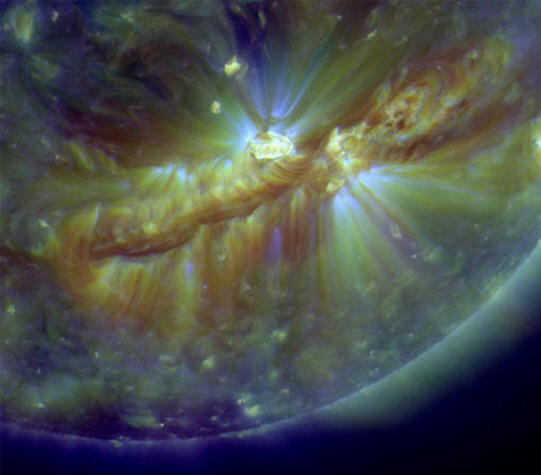|

A 400,000 kilometer long prominence
emerges from the Sun.
Credit: Solar Dynamics
Observatory/Goddard Space Flight
Center.
Sunspot 1112
Oct 25, 2010
An extremely large filamentary
structure has appeared on the Sun.
Electric star theory presupposes
such formations.What is the
Sun? And by extension, what are
stars? A
popular website describes
the Sun in this way: "Our Sun is
made up of elements left over from
the Big Bang, elements formed from
dying stars, and elements created in
supernovae."
The basic premise of the Electric
Universe theory is that celestial
bodies are immersed in plasma and
are connected by circuits. Since the
Sun is also electrically
interconnected with the
galaxy and its planets, it should be
thought of as a charged object in
balance with the forces of its
environment. That balance is not
completely stable, however. The
currents flowing into and out of the
Sun can sometimes cause tremendous
bursts of energy called solar
flares.
According to consensus opinions,
solar flares, or coronal mass
ejections (CME), occur when magnetic
loops in the Sun's atmosphere
"reconnect" with each other, causing
a short circuit. The explosive
release of "magnetic energy" is said
to accelerate the superheated gases
out into space. No one knows what
"magnetic reconnection" is, but it
is offered as the only explanation
by heliophysicists for the flaring
phenomenon.
Since CMEs increase auroral
brightness and frequency when they
meet Earth's magnetic field,
deductive reasoning (and
instrumentality) identifies them as
a flow of charged particles.
Although space scientists refer to
the ion stream pouring out of the
Sun as a "wind," and that atomic
fragments "rain down" on Earth, that
they are attracted to and follow the
polar cusps should definitively
establish their electrical nature.
In the consensus view, when gas
and dust start to collapse into a
new star it naturally warms up and
radiates energy. Outward pressure,
it is said, opposes the inward force
of gravity. If the outward force
wins and overcomes the force of
gravity, the atoms in the gas will
never be compressed enough to
undergo nuclear fusion. However, if
the body is massive enough gravity
continues to compress the star until
its core becomes so hot and dense
that thermonuclear reactions can
begin to resist further compression
and a star is born.
The discovery of a "solar wind"
escaping the Sun at almost 700
kilometers per second was surprising
in light of the thermonuclear fusion
theory. In a gravity-driven
Universe, the Sun's heat and
radiation pressure are insufficient
to explain how the particles of the
solar wind accelerate past Venus,
Earth and the rest of the planets.
Since they are not rocket powered,
no one expected such acceleration.
According to conventional
doctrine, the Sun accelerates
electrons (and protons) away from
its surface in the same way that
sound waves are amplified. Energetic
pulsations in the solar photosphere
travel upward through "acoustical
wave-guides," called
magnetic flux tubes, that
push “hot gas” outward. In an
Electric Universe populated by
electric stars there is a more
obvious explanation: electric fields
in space can accelerate the charged
solar particles, creating coherent
electric currents that flow through
the Solar System.
Solar flares can therefore be
thought of as tremendous lightning
bursts, discharging vast quantities
of matter at near relativistic
speeds. The circuit connecting the
Sun with the Milky Way probably
extends for thousands, if not
hundreds of thousands of
light-years. How much electrical
energy might be contained in such
magnetically confined “transmission
lines” feeding the solar anode?
As
the Electric Sun theory
relates, sunspots, flares, coronal
heating, and all other solar
activity most likely results from
changes in the electrical input from
our galaxy.
Birkeland current filaments
slowly rotate past the Solar System,
supplying more or less power to the
Sun as they go.
The giant filament recently
observed in association with sunspot
1112 reveals its electrical
parentage, proving Electric Universe
advocate
Wal Thornhill's assertions
that: "While enormous time and
resources have been poured into the
effort to understand stars based on
a single outdated idea, those
familiar with plasma discharge
phenomena have been paying close
attention to the observed phenomena
on the Sun and finding simple
electrical explanations. After 100
years of neglect, an electrical
model of stars is just beginning to
emerge. It is an engineer’s view
that offers a coherent understanding
of our real place in the universe
(cosmology) and practical insights
for the future exploration of space.
If the Sun shines as an electric
light ‘plugged in’ to the Electric
Universe, the objective tests become
obvious. Perhaps, with a real
understanding of stars we may reach
childhood’s end in the cosmos."
Stephen Smith
|







